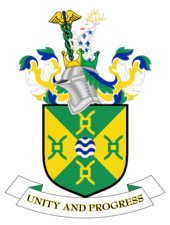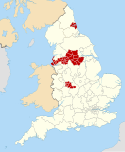Sandwell Metropolitan Borough Council
Sandwell Metropolitan Borough Council | |
|---|---|
 | |
 | |
| Type | |
| Type | |
| Leadership | |
Shokat Lal since November 2022[2] | |
| Structure | |
| Seats | 72 councillors |
Political groups |
|
Joint committees | West Midlands Combined Authority |
| Elections | |
| First past the post | |
Last election | 2 May 2024 |
Next election | 7 May 2026 |
| Meeting place | |
 | |
| Sandwell Council House, Freeth Street, Oldbury, B69 3DB | |
| Website | |
| www | |
Sandwell Metropolitan Borough Council, or Sandwell Council, is the local authority of the Metropolitan Borough of Sandwell in the West Midlands, England. It is a metropolitan borough council and provides the majority of local government services in the borough. The council has been a member of the West Midlands Combined Authority since 2016.
The council has been under Labour majority control since 1979. It is based at the Council House in Oldbury.
History[edit]
The metropolitan district of Sandwell and its council were created in 1974 under the Local Government Act 1972, covering the combined area of the former county boroughs of Warley and West Bromwich, which were both abolished at the same time.[3] It was the second major overhaul of local government structures in the area in eight years; the borough of Warley had only been created in 1966 as a merger of the old boroughs of Oldbury, Rowley Regis and Smethwick, whilst the borough of West Bromwich had been enlarged in 1966 to absorb the area of the abolished boroughs of Tipton and Wednesbury (along with more minor adjustments to the boundaries with other neighbours).[4][5]
The new district was named Sandwell and it was one of the seven districts in the new metropolitan county of the West Midlands.[6] The first election to the new council was held in 1973. For its first year the council acted as a shadow authority alongside the area's outgoing authorities. The new metropolitan district and its council formally came into being on 1 April 1974, at which point the old districts and their councils were abolished.[3] The metropolitan district was awarded borough status from its creation, allowing the chair of the council to take the title of mayor.[7]
From 1974 until 1986 the council was a lower-tier authority, with upper-tier functions provided by the West Midlands County Council. The county council was abolished in 1986 and its functions passed to the county's seven borough councils, including Sandwell, with some services provided through joint committees.[8]
Since 2016 the council has been a member of the West Midlands Combined Authority, which has been led by the directly elected Mayor of the West Midlands since 2017. The combined authority provides strategic leadership and co-ordination for certain functions across the county, but Sandwell Council continues to be responsible for most local government functions.[9][10]
Politics[edit]
Most of Sandwell's councillors are members of the Labour Party, with the Labour party having run the council since the first election in 1973, apart from one year between 1978 and 1979 when the Conservatives had a majority. By 2014, all but two of Sandwell's 72 councillors were Labour members.[11]
In May 2021 the Conservative Party regained its presence on the Council, gaining 9 seats from the Labour Party.[citation needed]
In May 2013, it was announced that following a re-shuffle, there was a freeze on allowances for Sandwell Council Cabinet Members and that the membership of the cabinet was reduced from 10 to 8.[12]
Recent history[edit]
Despite being the 14th most deprived borough in the UK, the council has invested and worked with many partners to ensure the regeneration of the borough attracting many new SME businesses. The Leader of the Council said that "successful small businesses are essential for the economy and for thriving local communities"[13]
Since its formation in 1974, the borough council has demolished a considerable percentage of the area's privately owned 19th and early 20th century housing stock. In the early years of this process, many of these properties lacked a bathroom or indoor toilet, as well as being generally unfit for human habitation, with refurbishment not deemed to be a viable option. The process of demolishing similar properties had in fact started before 1974 during the existence of the former West Bromwich and Warley boroughs, as well as before 1966 under the original local authorities. The borough council has also made money available for refurbishment of older private sector housing which is still deemed viable for retention.
Since the late 1980s, however, it has also demolished a considerable amount of post-1919 council housing. The first large redevelopment of this time came in 1992–3, when the West Smethwick Estate (known locally as the "Concrete Jungle" due to its network of interlinked concrete-constructed maisonette blocks) was demolished, despite only being around 25 years old, and replaced by a new low-rise housing estate known as Galton Village. Between 1992 and 2000, six of the nine tower blocks on the Lion Farm Estate in Oldbury (built in the early 1960s) were demolished and most of the land redeveloped with new housing.
Since 1989, parts of the Hateley Heath Estate in West Bromwich (mostly built in the late 1940s and early 1950s) have been demolished, including a section of maisonettes which were demolished in 1992 due to their unpopularity with potential tenants, as well as extensive vandalism of some of the properties while they were empty. In 1997 tenants on five estates representing 5,000 council homes voted against transferring their tenancies out of council control. Sandwell was one of the first areas to reject stock transfer.
Between 2000 and 2005, Carisbrooke House multi-storey flats and several blocks of low-rise flats (all built in the 1960s) were demolished on the Friar Park Estate in Wednesbury, while the council has retained and updated the much older houses which make up the bulk of the estate.
Two of the four tower blocks on the 1960s Riddins Mound Estate in Cradley Heath were demolished in 1996. The remaining properties in the area, including the two surviving tower blocks, have been refurbished.
Part of the 1930s Tibbington Estate in Tipton was demolished in the 1980s due to mining subsidence, and the land redeveloped with a sheltered housing scheme which opened in 1991. Another section of the estate was demolished in 2007 and redeveloped with a new public park as well as a small development of bungalows. Elsewhere in Tipton, several maisonette blocks on the 1960s Glebefields Estate were demolished between 1989 and 1992, and the estate's two tower blocks were demolished in 2004.
A large percentage of the multi-storey flats and maisonette blocks which were built during the 1950s, 1960s and early 1970s in the areas which now make up Sandwell have been demolished.
Children's Services – In April 2013, an OFSTED report criticised Sandwell's children's services highlighting failings around domestic violence and rating the service inadequate.[14] The following month, the council gave its backing to ambitious plans to make its children's service amongst the best in the country by teaming up with private sector firm iMPOWER.[15] However, services continued to underperform and the service was moved out of local authority control and into a Children's Trust.
Projects[16] include:
Smethwick Regeneration: Midland Metropolitan University Hospital, Windmill Eye NeighbourHood and a £23.5 million redevelopment of Holly Lodge College of Science (creating a state of the art learning environment for 1,250 pupils), the Portway Lifestyle Centre, Wednesbury Leisure Centre, The Crofts and Charlemont Flats
Regeneration of West Bromwich: a significant piece of investment including provisions for new retail, entertainment, arts, education and transit links. Despite the delays, it is anticipated that the majority of the regeneration will be completed by early 2014. One of the most controversial projects has been that of The Public, a community arts venue. In November 2013 venue was closed after the council decided that it would no longer subsidise it as an Arts Centre.[17] The Council announced in October 2013 that it had entered into an agreement with Sandwell College to take over the building, converting it into a Sixth Form college.[18] It is proposed that the council would need to borrow the money to refit the £70 million arts centre to make it suitable for the college whilst investors in the original project may sue the council if this proposal were to go ahead.[19]
The leader of Sandwell Council, Darren Cooper, died suddenly on 26 March 2016, while in office. He was succeeded by deputy leader Steve Eling.[20]
Elections[edit]
Since the last boundary changes in 2004, the council has comprised 72 councillors representing 24 wards, with each ward electing three councillors. Elections are held three years out of every four, with a third of the council (one councillor for each ward) elected each time for a four-year term of office.[21]
Premises[edit]
The council's headquarters are at the Council House on Freeth Street in the town centre of Oldbury. The building opened in 1989.[22]
References[edit]
- ^ Barnett, Christian (22 May 2024). "First female Muslim mayor appointed by council". BBC News. Retrieved 11 June 2024.
- ^ "Sandwell Council appoints new chief executive". BBC News. 9 November 2022. Retrieved 15 June 2023.
- ^ a b "Local Government Act 1972: Schedule 1", legislation.gov.uk, The National Archives, 1972 c. 70 (sch. 1), retrieved 30 May 2024
- ^ "West Bromwich Municipal Borough / County Borough". A Vision of Britain through Time. GB Historical GIS / University of Portsmouth. Retrieved 11 June 2024.
- ^ "Warley County Borough". A Vision of Britain through Time. GB Historical GIS / University of Portsmouth. Retrieved 11 June 2024.
- ^ "The Metropolitan Districts (Names) Order 1973", legislation.gov.uk, The National Archives, SI 1973/137, retrieved 11 June 2024
- ^ "District Councils and Boroughs". Parliamentary Debates (Hansard). 28 March 1974. Retrieved 30 May 2024.
- ^ "Local Government Act 1985", legislation.gov.uk, The National Archives, 1985 c. 51, retrieved 5 April 2024
- ^ "The West Midlands Combined Authority Order 2016", legislation.gov.uk, The National Archives, SI 2016/653, retrieved 11 June 2024
- ^ "Understand how your council works". gov.uk. Retrieved 30 May 2024.
- ^ "England council elections". BBC News. Retrieved 29 August 2011.
- ^ "Freeze on allowances for Sandwell Council cabinet members " Express & Star". Express & Star. 22 May 2013. Retrieved 19 September 2016.
- ^ "Latest news | Sandwell Council". Government of the United Kingdom. Retrieved 19 September 2016.
- ^ "Taskforce to be formed for children most at risk in Sandwell " Express & Star". Express & Star. 25 April 2013. Retrieved 19 September 2016.
- ^ "Latest news | Sandwell Council". Government of the United Kingdom. Retrieved 19 September 2016.
- ^ "Regenerating Sandwell | Sandwell Council". Government of the United Kingdom. Retrieved 19 September 2016.
- ^ Hallam, Katy (13 November 2013). "West Bromwich arts centre The Public closes for good". Birmingham Mail. Retrieved 19 September 2016.
- ^ Deal on The Public is signed
- ^ Haywood, Bob (19 May 2013). "Investors in The Public in West Brom could be set to sue". Birmingham Mail. Retrieved 19 September 2016.
- ^ "Sandwell Council leader Darren Cooper dies – BBC News". BBC. 27 March 2016. Retrieved 19 September 2016.
- ^ "The Borough of Sandwell (Electoral Changes) Order 2003", legislation.gov.uk, The National Archives, SI 2003/2510, retrieved 11 June 2024
- ^ "Sandwell Council House - Sandwell Council House Freeth Street Oldbury UK Oldbury, B69 3DE England - Administrative | Honest Buildings". Archived from the original on 6 June 2014. Retrieved 2 June 2014.

